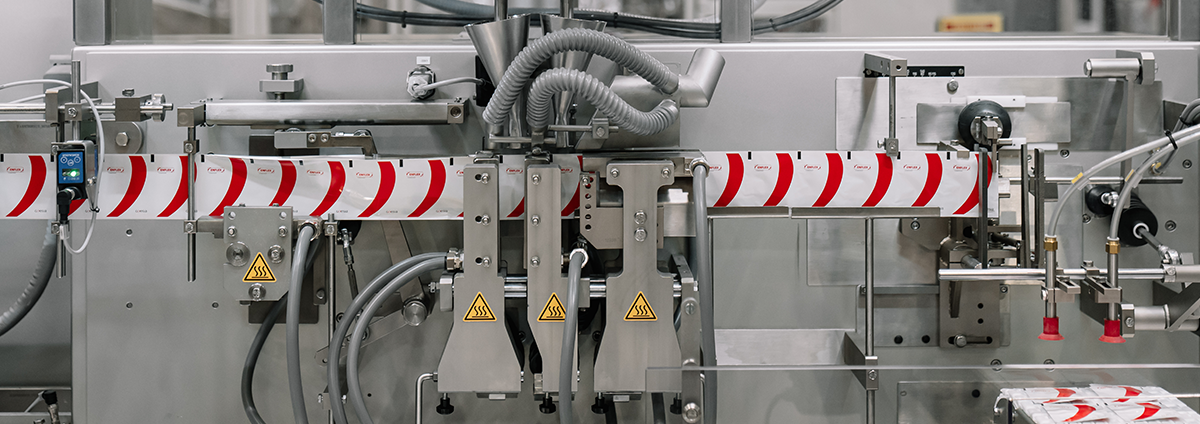HFFS Technology: Elevating Packaging Standards for Healthcare and Pharmaceutical Products
In the healthcare and pharmaceutical industries, packaging must adhere to exceptionally high standards. It is not enough to ensure product integrity and safety; the packaging must also deliver in terms of quality and reliability. While vertical form fill seal (VFFS) machines have been widely used in the industry for years, horizontal form fill seal (HFFS) technology has emerged as a compelling alternative.
With its potential to enhance pouch quality, improve seal reliability, and streamline operations, HFFS technology is gaining significant attention.
Horizontal Packaging Technology: Film quality & efficient operations
The distinguishing feature of HFFS machinery lies in its horizontal configuration. Unlike vertical systems, HFFS technology feeds the film horizontally through a carefully orchestrated sequence of stations. This approach significantly reduces mechanical stress on the packaging film, preserving its integrity. By preventing excessive stretching and strain, the film remains in optimal condition, resulting in tighter, more secure seals.
Moreover, the complete accessibility to each station in HFFS systems makes the machines easier to operate, maintain, and clean.
The Core Stages of HFFS Packaging Systems
HFFS machines break down the packaging process into a well-defined series of operational stages, which may vary depending on the machine configuration .
1. Unwinder
The process begins with unwinding the packaging material from a reel. This station includes a splicing table for manual or automatic reel changes and a reel aligner to maintain the even alignment of both pouch faces. A forming triangle then folds the film, preparing it for pouch forming. These technical enhancements ensure the material is delivered in the best condition for subsequent stages.
2. Pouch Forming
Vertical sealing bars shape the sachets into the desired configuration, whether flat pouches with three or four seals or other formats. After shaping, the film is cut using precision cutting scissors, producing already-formed pouches with consistent dimensions and aesthetic appeal.
3. Dosing or Filling
Once the pouch is formed, the product - liquid, solid, or powder - is dispensed into the partially formed pouch. This stage uses advanced systems like augers, volumetric fillers, or pumps to ensure precise filling. The fix beam holds the pouches steady during filling, while the walking beam transports them through different stations. Depending on the setup, multiple filling stations can handle various product types simultaneously.
4. Top Sealing
After filling, the top sealing station creates individual, tightly sealed units. This stage typically involves two sealing units - one for structural integrity and another for appearance. A cooling unit flattens and cools the seals for a perfect finish, ensuring the pouches meet high-quality standards.
5. Exit
Finally, the filled and sealed pouches are dispatched. Depending on the end-of-line solution, the pouches may exit via ramps, pick-and-place arms, or belt conveyors, ready for further processing or distribution.
Versatility and Compatibility: Meeting Diverse Market Needs
Adaptability is one of the greatest advantages of HFFS technology. Healthcare and pharmaceutical products often come in a wide range of formats, requiring different packaging configurations. HFFS machinery can produce flat pouches, stand-up pouches, gusseted bags, and specialized spouted pouches with minor adjustments. This flexibility accommodates emerging product lines, shifts in market demand, and evolving regulatory requirements.
The machines are also compatible with a broad range of materials, including laminated films with barrier layers that protect products from moisture, oxygen, and contaminants. By preserving the integrity of these materials during the packaging process, HFFS systems ensure products are safely sealed to meet stringent industry standards.
Precision and Customization: Enhancing Functionality
In healthcare and pharmaceutical packaging, accuracy is a necessity. HFFS machines integrate advanced dosing systems that deliver precise filling, whether for liquids, powders, or high-density liquids. Control interfaces monitor key parameters like seal temperature, pressure, and timing, ensuring consistent and reliable results.
Additionally, the modular design of HFFS machinery allows for customization. Features such as zipper applicators, hole punch systems, and custom printing can be integrated to meet specific customer requirements. These enhancements add functionality and allow manufacturers to tailor their packaging to individual product needs.
A Clear Alternative to VFFS for Enhanced Pouch Quality
While VFFS machines have long been a staple in healthcare and pharmaceutical packaging, HFFS technology offers clear advantages. Its horizontal approach fosters pouch integrity, reduces film stress, and ensures consistent seal standards. The accessibility of working stations, combined with multiple customizable options, positions HFFS machinery as a forward-looking solution poised for growing adoption.
By investing in HFFS technology, healthcare and pharmaceutical companies secure a packaging method that is efficient, versatile, and dedicated to enhancing product safety and quality. In a highly regulated and demanding market, the shift toward horizontal form fill seal systems represents a decisive step in addressing the challenges of modern packaging requirements.
Enflex, we HealthCare.
